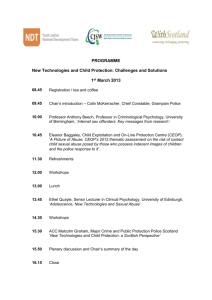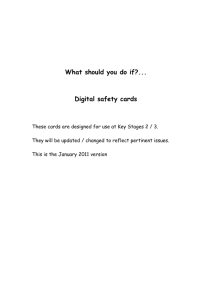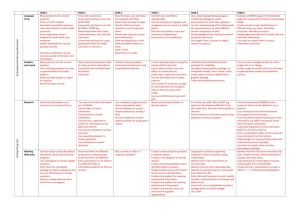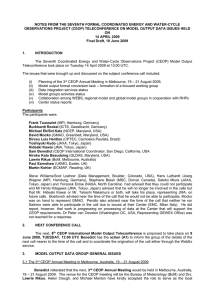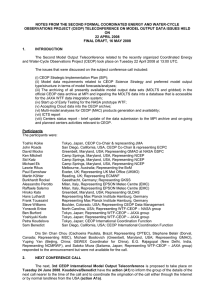NOTES FROM THE ELEVENTH FORMAL COORDINATED ENERGY AND WATER-CYCLE
advertisement
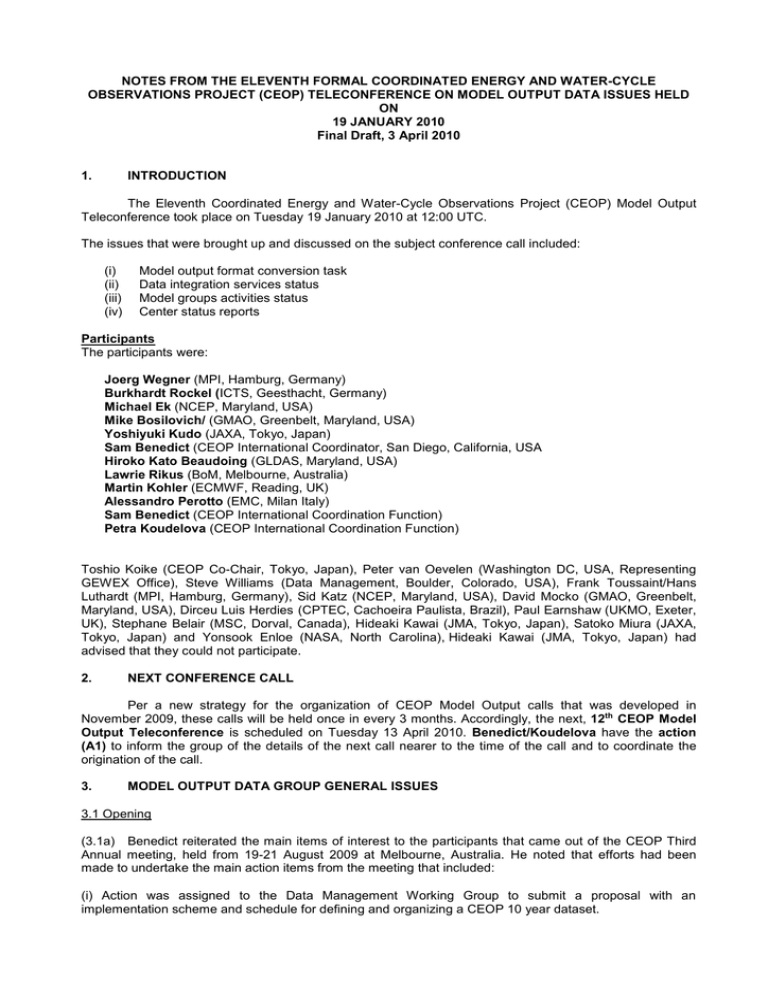
NOTES FROM THE ELEVENTH FORMAL COORDINATED ENERGY AND WATER-CYCLE OBSERVATIONS PROJECT (CEOP) TELECONFERENCE ON MODEL OUTPUT DATA ISSUES HELD ON 19 JANUARY 2010 Final Draft, 3 April 2010 1. INTRODUCTION The Eleventh Coordinated Energy and Water-Cycle Observations Project (CEOP) Model Output Teleconference took place on Tuesday 19 January 2010 at 12:00 UTC. The issues that were brought up and discussed on the subject conference call included: (i) (ii) (iii) (iv) Model output format conversion task Data integration services status Model groups activities status Center status reports Participants The participants were: Joerg Wegner (MPI, Hamburg, Germany) Burkhardt Rockel (ICTS, Geesthacht, Germany) Michael Ek (NCEP, Maryland, USA) Mike Bosilovich/ (GMAO, Greenbelt, Maryland, USA) Yoshiyuki Kudo (JAXA, Tokyo, Japan) Sam Benedict (CEOP International Coordinator, San Diego, California, USA Hiroko Kato Beaudoing (GLDAS, Maryland, USA) Lawrie Rikus (BoM, Melbourne, Australia) Martin Kohler (ECMWF, Reading, UK) Alessandro Perotto (EMC, Milan Italy) Sam Benedict (CEOP International Coordination Function) Petra Koudelova (CEOP International Coordination Function) Toshio Koike (CEOP Co-Chair, Tokyo, Japan), Peter van Oevelen (Washington DC, USA, Representing GEWEX Office), Steve Williams (Data Management, Boulder, Colorado, USA), Frank Toussaint/Hans Luthardt (MPI, Hamburg, Germany), Sid Katz (NCEP, Maryland, USA), David Mocko (GMAO, Greenbelt, Maryland, USA), Dirceu Luis Herdies (CPTEC, Cachoeira Paulista, Brazil), Paul Earnshaw (UKMO, Exeter, UK), Stephane Belair (MSC, Dorval, Canada), Hideaki Kawai (JMA, Tokyo, Japan), Satoko Miura (JAXA, Tokyo, Japan) and Yonsook Enloe (NASA, North Carolina), Hideaki Kawai (JMA, Tokyo, Japan) had advised that they could not participate. 2. NEXT CONFERENCE CALL Per a new strategy for the organization of CEOP Model Output calls that was developed in November 2009, these calls will be held once in every 3 months. Accordingly, the next, 12th CEOP Model Output Teleconference is scheduled on Tuesday 13 April 2010. Benedict/Koudelova have the action (A1) to inform the group of the details of the next call nearer to the time of the call and to coordinate the origination of the call. 3. MODEL OUTPUT DATA GROUP GENERAL ISSUES 3.1 Opening (3.1a) Benedict reiterated the main items of interest to the participants that came out of the CEOP Third Annual meeting, held from 19-21 August 2009 at Melbourne, Australia. He noted that efforts had been made to undertake the main action items from the meeting that included: (i) Action was assigned to the Data Management Working Group to submit a proposal with an implementation scheme and schedule for defining and organizing a CEOP 10 year dataset. (ii) The CEOP Co-Chairs agreed to take action to use existing material contained in the CEOP submittal to the WCRP/GEWEX Legacy document to develop a draft of the initial CEOP Synthesis Document by the end of October 2009, with submission set for early 2010. However, this action will involve many members of the CEOP community before it is submitted for publication. (iii) Activation of a number of small Task Teams including a Hydrologic Applications Project (HAP) Team, Land Modeling Team and a Global to Regional Scale Analysis Team. (iv) It was agreed that CEOP would embrace some of the main tenets of Adaptation to Climate Change (ACC) and would look into ways of contributing to those in a direct manner. Some ideas related to this consensus were: (i) Identifying Regional to local Impacts of ACC on the hydroclimate in RHP basins, (ii) Quantifying uncertainty by using CEOP data infrastructure, (iii) Testing models and ACC scenarios by apply WEBS analysis techniques and (iv) Exploiting CEOP/RHP connections to local/basin scale model Centers to assist in ACC work In particular, initial conference calls have been held that focused on CEOP Hydrologic Applications Project (HAP) and other CEOP fast track activities. 3.2 JAXA CEOS/WGISS Test Facilities (WTF) for CEOP (3.2a) Kudo reiterated that the JAXA WTF for CEOP team has been allocated a budget for expansion of their Distributed Data Integration system’s capabilities and inclusion of the CEOP Phase 2 data. He introduced the plan for such expansion referring to the PPT document (JAXA'sPlanForPhase2.ppt) that was distributed to the participants prior to the call (see Attachment 1 below). To accomplish this upgrade of the system, the team plans firstly to develop a suitable design of the new features and Kudo asked the Center representatives for their kind cooperation in this process. In particular, the MPI/DKRZ team is asked to consider the proposed interface between the WTF system and the MPI/DKRZ archive, which is an OPeNDAP method for the MOTLS data and Jblob function for the gridded output, and comment on it. In order to discuss this issue in more details a separate email communication and/or conference call may be needed between the JAXA and MPI/DKRZ teams including Kudo, Toussaint/Luthardt/Wegner, and Koike. In addition, similar communication and agreement is needed with other data centers, namely NCAR/EOL for in-situ data (Williams, Loehrer) and University of Tokyo (Koike, IT group) for the satellite data. Benedict and Koudelova will assist Kudo to coordinate this communication (action A2). In this context, the Center representatives inquired if the WTF-CEOP system could access their own gridded output databases since it would make the data accessible through the system without transferring them to the MPI/DKRZ database. JAXA team will discuss this point with CEOP Co-Chair, T. Koike (action A2a). (3.2b) Kudo further voiced that, during this reporting period, the system hardware has continued to run smoothly at: http://ceop.restec.or.jp/. 3.3 CEOP Model Output format issues (3.3a) Benedict reiterated that the group had agreed upon the following items related to the Model Output format standardization across the contributing Centers and had begun to undertake the necessary actions to achieve the agreed to standards: (i) A "standard naming convention" for the CEOP MOLTS station name (ii) A “standard” CEOP data file naming convention (iii) A comprehensive list of CEOP standard variable names (iv) Application of Netcdf JMA Fortran Routines The details of the discussions on the above points that took place during several past conference calls including a special call of the Format Working Group were summarized in the Notes from the previous call. (3.3b) Rockel voiced that he had received response from 4 Centers regarding the Unified table of the MOLTS variables that was introduced on previous calls. He appreciated this input but it was pointed out that responses from other Centers were important for moving ahead with the MOLTS data homogenization work. It was reiterated that the table included the list of all of the variables being provided by the Centers and for each of these variables it indicated number of centers that provide it in their output, the CF standard name and CF unit, the cell method, and long name. In this context, all the Center representatives, who had not done it yet, were asked to fill out this table (action A3). As an example of how the table can be filled out to provide the desired information, the result of the update provided by Sid Katz at NCEP was circulated. Katz has noted in column “I” whether or not the NCEP model generates the variable and then in virtual column “J” he notes “DIFFERENCES”. Rockel mentioned that the analysis of the 4 inputs he had received suggested that the homogenization would be possible. In most cases individual parameter differences across these four Centers were relatively simple (different unit, total value over the time step or rate) and thus the conversion will not be too demanding. (3.3c) In addition, it was stressed out again that it would be highly desirable to update model output documentation. The center representatives were asked to review the documentation currently in the database associated with their Center’s data and update it as soon as practical (action A3a). 3.4 MPI/DKRZ Current Status Wegner advised the group that since 1 January 2010, their data center (World Data Center for Climate: WDCC) has been affiliated with German Climate Computing Centre (DKRZ) rather than MPI. Nevertheless, this change will not affect the work the team is contributing on behalf of CEOP. Wegner also mentioned that they had certain issues with the hardware and thus some downloads might not be possible but the team is working on resolving these issues. 3.5 CEOP Global Model Study (http://gmao.gsfc.nasa.gov/research/modeling/validation/ceop.php) Bosilovich reiterated that the new, 2.0 version of the dataset had been added to their ftp site (ftp://agdisc.gsfc.nasa.gov/private/ceop/). It includes ERA Interim, GMAO and JMA reanalyses data and in addition to the previous version, it provides daily and monthly basin averages including MDB and La Plata basins. The data is available for download but the detailed documentation is still underway. 4. CURRENT STATUS OF NWPCs 4.1 GLDAS by Hiroko Kato Kato reiterated that all the GLDAS gridded data was available in the Grib format at the NASA server and that she was working with the DKRZ team to prepare for the data transfer to the DKRZ database. Kato further mentioned that the GLDAS team was working on a new generation dataset using Princeton forcing data for the years 1948 - 2000. 4.2 BoM by Lawrie Rikus Rikus reiterated that the gridded data were available in the Grib format and would be provided to the DKRZ archive soon. He further voiced that they had begun to run the completely new modeling system but still were encountering certain issues. Rikus will advise the group of further progress on the next call. 4.3 GMAO by Mike Bosilovich Bosilovich reported that the 30 years of the GMAO reanalysis had been completed and would be available on-line through the NCDC server soon. 4.4 NCEP by Mike Ek Ek reiterated that the NCEP gridded data (1 June 2008 up to current) were prepared for sending to DKRZ and that they continued generation of the CEOP MOLTS from the operational data. The JMA format conversion subroutine will be employed in the near future and since then, the output will be provided in the required netcdf format. 4.5 EMC by Alessandro Perotto Perotto reported that EMC had completed their model system upgrade and test runs were successful. They are still anticipating new hardware to begin with operational runs from which the CEOP data will be generated. 4.6 ECMWF by Martin Köhler Köhler reported that the ECMWF team was just finalizing an upgrade of their forecasting modeling system that included higher spatial as well as vertical resolution. Köhler also informed the group that he had accepted a new position at the German Weather Service since April and thus would leave the ECMWF team and would stop serving as the ECMWF representative for CEOP. A new contact person will be identified through discussion with Martin Miller at ECMWF. Participants on the call thanked Köhler for his great efforts contributed on behalf of the CEOP Model Output working group. The call was adjourned at 13:00 UTC. ATTACHMENT 1:

